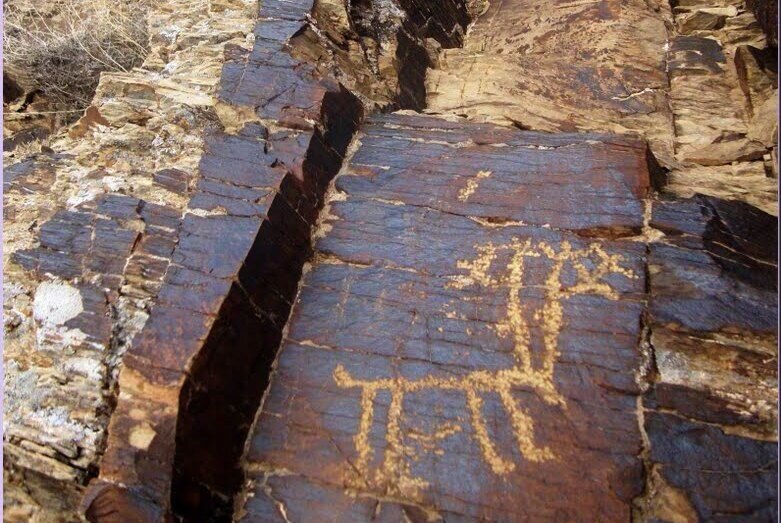Evidence suggests prehistorical Iranians migrated to Americas

TEHRAN – Some prehistorical residents of the Iranian plateau migrated to the Americas, an Iranian archaeologist and researcher says based on evidence from similarities between the petroglyphs and cave painting symbols in central Iran and the ones found in the Americas.
“After years of exploring ancient paintings inside Iran’s caves and mountains and other parts of the globe, amazing achievements have been made in this regard,” Mohammad Nasserifard told IRNA in an interview released on Tuesday.
“The ancient paintings of cave walls and mountains in Iran have been compared with ones in other parts of the world, their similarities in appearance and motifs have been ‘amazing’, according to quotes by professors Jan Brouwer and Gus van Veen,” Nasserifard said, adding “His research and findings are presented to enthusiasts and researchers for the first time.”
The archaeologist underlined that such petroglyphs may be a missing link in human history and arts.
“Appearance similarities, artistic styles, and uniform themes of ancient petroglyphs and cave paintings of this land (Iran) reveal many missing links in human history and arts one of which is the resemblance of ancient artifacts in Iran with ones found in the American continent.”
“These migrations took place from the Bering Strait, in an area between the northeast of Asia and the northwest of the Americas, or from the frozen oceans before the tenth millennium BC. One of the paintings, found among mountain petroglyphs in Khomein, depicts a hunter man on horseback, which alike the American Indians, carries blades made of birds’ feathers on his back.”“The discovery of equestrian motifs with leopard-like horses in Iran, which the Indians called ‘Appaloosa’, is one of the reasons for this migration, which can be seen on the walls of caves and mountains of Qasr-e-qand and Neyshekar regions which date from 11,000 years ago. They are similar to the leopard-like horses of Baluchestan.”
Nasserifard said French archaeologists had previously said that paintings of leopard horses on the Maral Cave showed a special species of horse, which lived only in Europe, while women living in Balochistan 11,000 years ago saw such a genuine Iranian horse. They are domesticated and seen riding on the walls of the mountains of Balochistan, and the footprints of the Indian dream horse, Apalusa, are the same leopard horse taken from ancient Iran by immigrants to the Americas.
He noted that studies of Iranian lithographs, especially ones carried out on the Teymareh rock art site in Khomein county, central Iran, show that thousands of years ago, the inhabitants of the Iranian plateau migrated to the Americas.
“These migrations took place from the Bering Strait, in an area between the northeast of Asia and the northwest of the Americas, or from the frozen oceans before the tenth millennium BC. One of the paintings, found among mountain petroglyphs in Khomein, depicts a hunter man on horseback, which alike the American Indians, carries blades made of birds’ feathers on his back.”
Elsewhere in his remarks, Nasserifard explained “This type of cover and hunting can be seen among Indians living in different parts of the Americas through documents and photographs taken, … , these numerous prehistorical figures can show the migration of the inhabitants of the Iranian plateau to the American continent during the past millennia.”
Earlier in March, a team of entomologists and archaeologists concluded that a previously-founded petroglyph showcases a six-limbed creature with the head and arms of a praying mantis. The rare 14-centimeter rock carving was first spotted in the Teymareh rock art site in Khomein county, central Iran, during surveys between 2017 and 2018, but could not be identified due to its unusual shape.
Jan Brouwer and Gus van Veen have examined the Teymareh site estimating its carvings were made 40,000-4,000 years ago.
One can only guess why prehistoric people felt the need to carve a mantis-man into rock, but the petroglyph suggests humans have linked mantis to the supernatural since ancient times. As stated by the authors, the carving bears witness, "that in prehistory, almost as today, praying mantis were animals of mysticism and appreciation."
Prehistoric rock art provides insights into past eras and cultures as archaeologists classify the tools for the carvings by specific eras Incising tools include flint, metal, or thigh bones of hunted prey.
AFM/MG
